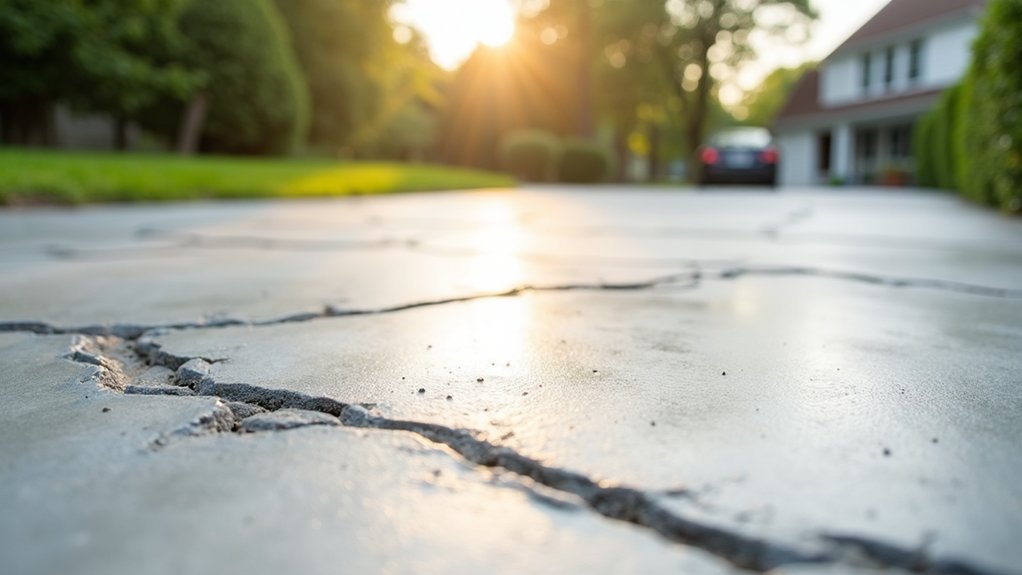Yes, a concrete driveway requires expansion joints to effectively manage thermal expansion and contraction. These joints help absorb stress, preventing cracking and damage while enhancing durability. They are crucial for maintaining the integrity of the slab and avoiding expensive repairs. Properly placed joints at key locations reduce the risks of issues like shifting and buckling. Understanding the right materials and installation methods can further improve your driveway’s lifespan.
Table of Contents
ToggleKey Takeaways
Expansion joints are vital for managing thermal expansion and contraction in concrete, helping to prevent cracking and structural damage. They function as safety valves, allowing for controlled movement and reducing internal stress within the slabs.
Without these joints, uncontrolled movement can result in significant cracking and displacement, leading to expensive repairs in the long run. Properly installed expansion joints not only enhance the durability of your driveway but also keep it looking good.
It’s important to regularly maintain these joints to ensure they remain effective and to extend the lifespan of your driveway.
Purpose of Expansion Joints in Concrete Driveways
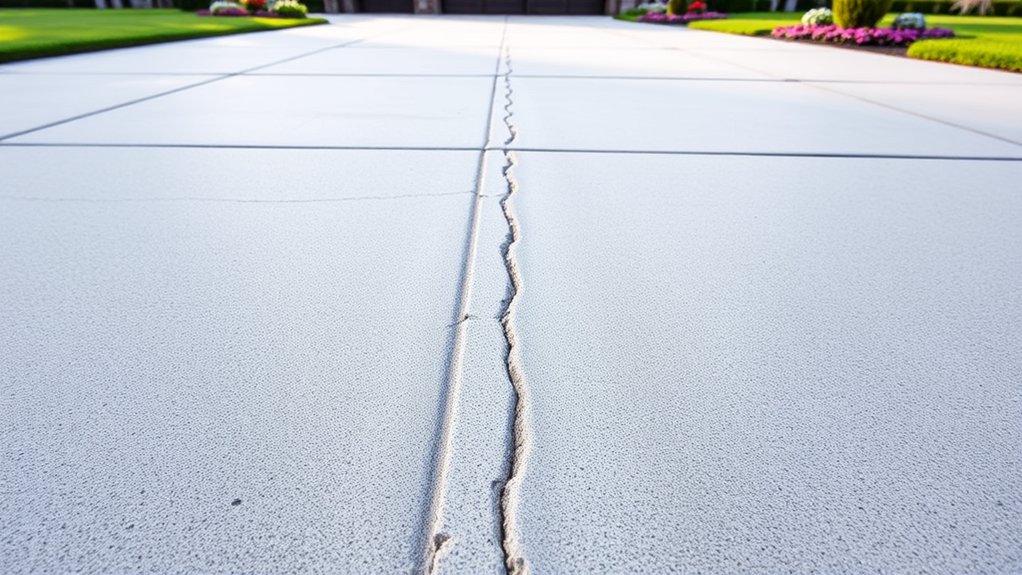
Expansion joints are essential for the proper functioning of concrete driveways. They help accommodate the thermal expansion and contraction of concrete slabs, reducing internal stress caused by temperature changes. If joints aren’t spaced correctly, it can lead to uncontrolled cracking and structural damage.
Think of expansion joints like a safety valve for your driveway; they allow for movement, easing pressure on surrounding areas and preserving the integrity of the slabs. This design feature not only enhances the driveway’s durability but also reduces the likelihood of costly repairs and helps maintain its appearance. Proper installation of expansion joints is crucial for maximizing their effectiveness and longevity.
Incorporating expansion joints into your driveway design is a smart investment. It ensures a smooth, safe surface for daily use and protects your property in the long run.
Types of Joints Used in Concrete Driveways
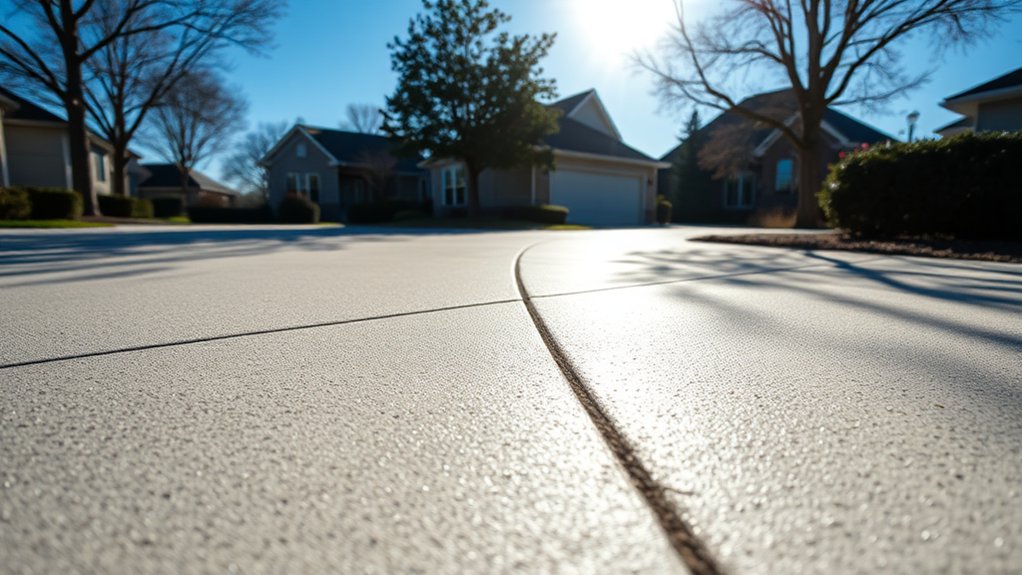
Understanding the types of joints used in concrete driveways is essential for ensuring their durability and performance. Common types include rubber, foam, concrete, asphalt, and specialty materials. Rubber expansion joints are flexible and long-lasting, making them suitable for handling temperature changes and resisting moisture. Foam joints, made from closed-cell polyethylene, are a cost-effective choice but may need replacing more often. Concrete expansion joints are typically used in commercial driveways, providing structural integrity but requiring professional installation. Asphalt joints, meant for asphalt surfaces, offer good weather resistance and durability. Specialty materials like cork and polypropylene foam can further improve resilience and recovery. Choosing the right joint type and installation method is crucial for your driveway’s functionality, especially under varying loads and weather conditions. Proper joint applications can help prevent stress that could cause concrete ruptures due to temperature and moisture changes.
Installation and Positioning of Expansion Joints
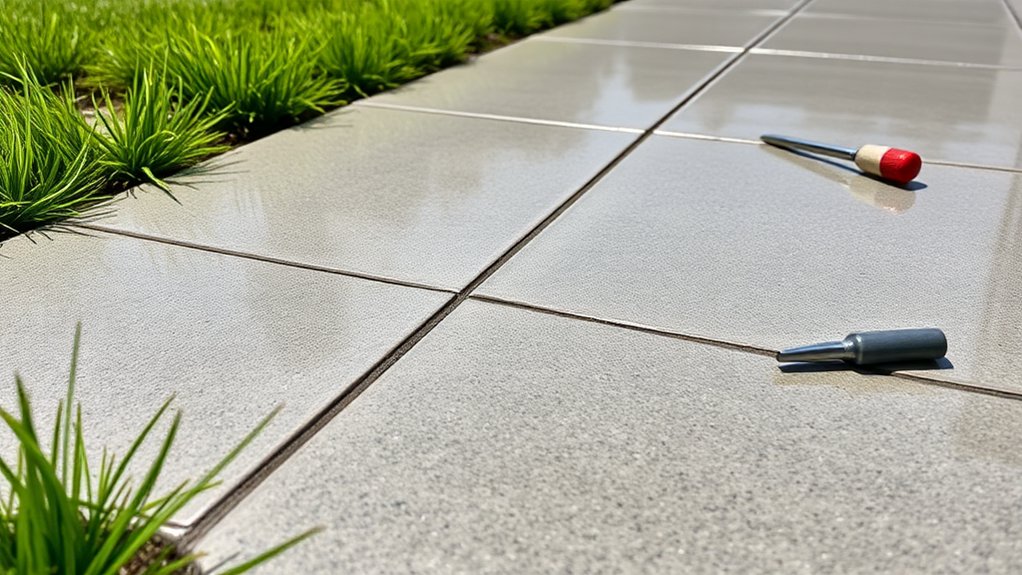
Proper installation and positioning of expansion joints are crucial for the durability of your concrete driveway. When planning, consider factors such as the local climate and the dimensions of your driveway. A good rule of thumb is to space joints approximately 40 times the slab thickness. Position the joints at natural stress points—like corners or where slabs meet—to help manage cracking effectively. Be aware of local conditions, such as freeze-thaw cycles, which can affect where you place the joints for optimal performance. Additionally, ensure that the expansion joints are maintained regularly to prevent deterioration that can lead to visible cracks. Avoid putting joints too close to the edges or existing cracks, as this can compromise the structure. Use a concrete saw for clean cuts, making sure they’re deep enough to relieve stress. After cutting, clean the joint thoroughly before applying any filler to ensure durability and proper waterproofing.
When Expansion Joints May Not Be Needed
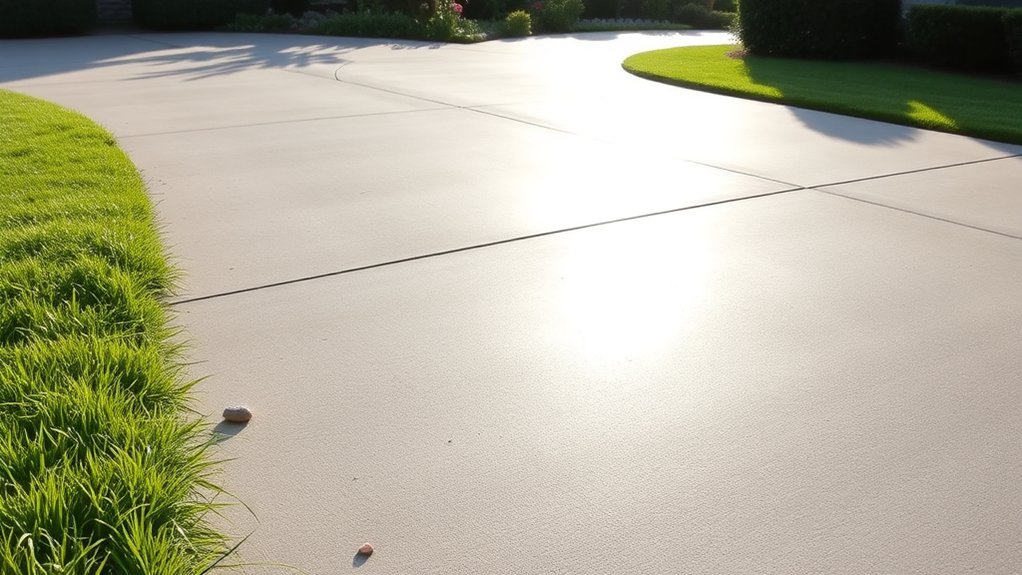
Expansion joints may not be required in certain cases, especially for smaller concrete driveways or slabs that are below specific size thresholds.
If your driveway is less than 100mm thick or covers an area of less than 9-18 square metres, you can often forgo expansion joints by using control joints instead.
These grooves help direct natural cracking, reducing the need for full joint separation.
Furthermore, alternatives such as compacted granular bases and isolated “floating” slabs can help alleviate stress, minimising the need for expansion joints.
In stable climates with few temperature changes, specific joint designs might be unnecessary, enabling simpler installation while still ensuring structural integrity.
Effects of Missing or Improper Expansion Joints
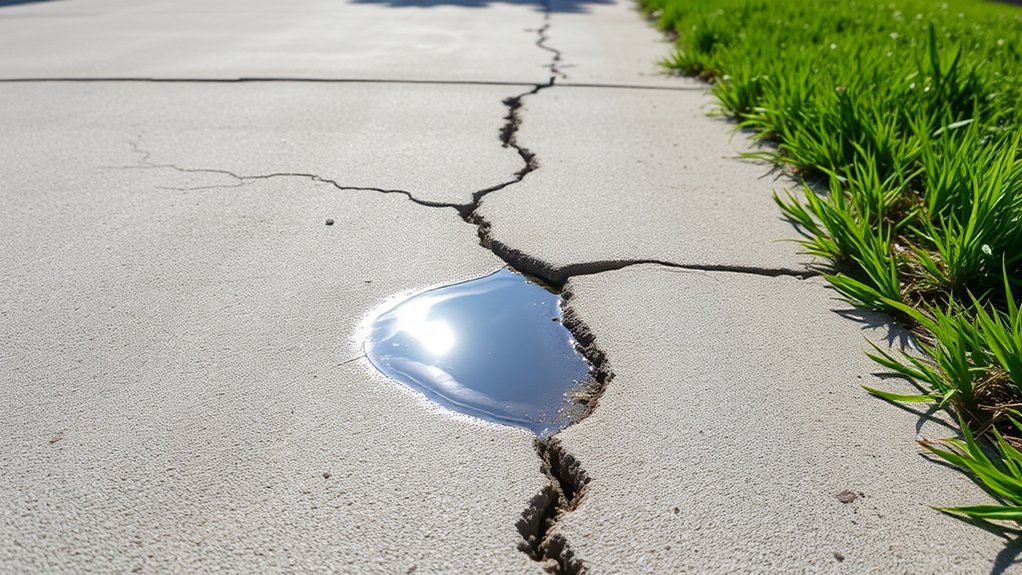
Missing or incorrectly positioned expansion joints can cause serious cracking and shifting in your concrete driveway.
As concrete expands and contracts with temperature fluctuations, the lack of joints allows for uncontrolled movement, leading to potentially costly repairs.
Tackling these issues promptly can save you from extensive damage and the hassle of having to replace your driveway.
Cracking and Displacement Risks
When concrete driveways lack sufficient expansion joints, they are prone to serious cracking and displacement issues. Without these joints, stress builds up, resulting in random cracks that can undermine both structural integrity and appearance. Key causes of cracking include temperature changes and excessive tensile stress, while displacement can lead to slabs shifting against one another, causing heaving or buckling.
| Cracking Causes | Displacement Effects | Visual Impact |
|---|---|---|
| Temperature changes | Slabs pressing against each other | Unsightly uneven surfaces |
| Stress concentration | Surface irregularities | Increased repair requirements |
| Weak points in the slab | Damage to neighbouring structures | Decreased structural integrity |
| Lack of movement relief | Risk of spalling | Aesthetic decline |
To reduce these risks, it’s crucial to implement expansion joints in your concrete driveway.
Long-Term Repair Costs
Properly installed expansion joints are crucial for reducing long-term repair costs associated with concrete driveways. Neglecting these joints leads to stress accumulation, resulting in cracks and structural issues.
Your cost analysis shows that repair strategies become significantly more expensive without proper joints; filling cracks can range from £1.50 to £3.00 per square foot. Over time, the absence of expansion joints worsens damage, leading to costly repairs compared to the initial installation costs.
Moreover, routine maintenance becomes more difficult, further driving up expenses. By prioritising expansion joints, you enhance the driveway’s longevity and protect your investment, ensuring lower repair costs and maintaining property value.
Regular inspections can save you a considerable amount of money in the long run.
Materials Used in Expansion Joints
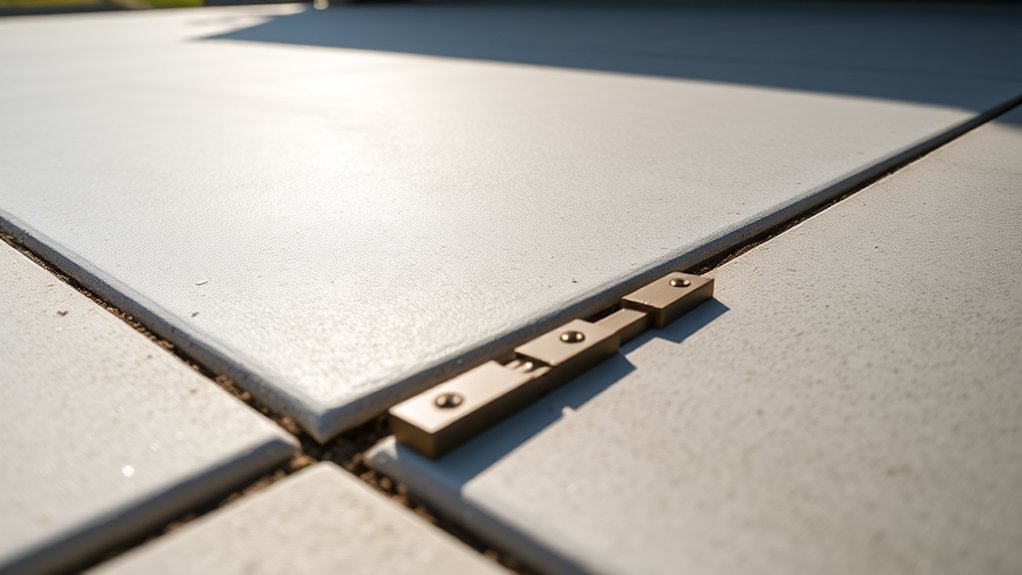
When choosing materials for expansion joints, consider common fillers such as synthetic foam, asphalt-based options, or cork.
Each material has its own durability and compressibility requirements, which can impact the performance of your concrete driveway.
Regular maintenance and inspections are crucial to ensure these joints work effectively over time, helping to prevent potential issues.
Common Joint Filler Materials
Expansion joints require reliable filler materials to manage movement and ensure the durability of concrete structures. Common types of joint fillers include polyvinyl, polyethylene, and cellulose, each with unique benefits.
Polyvinyl and polyethylene are flexible and robust, making them ideal for floor slabs. Cellulose is compressible and biodegradable, which suits environmentally-friendly projects.
Asphalt, known for its waterproof qualities, is great for outdoor uses like pavement repairs. For areas with significant movement, rubber joints provide both flexibility and strength.
Self-expanding cork joints can also expand notably to counteract concrete shrinkage. Choosing the right material depends on environmental factors, movement tolerance, and specific application requirements, ensuring optimal performance and longevity of the expansion joints.
Durability and Compressibility Requirements
To ensure your concrete driveway lasts and remains stable, it’s crucial to understand the durability and compressibility requirements of expansion joint materials.
Choose materials that can compress between 25% to 50% of their thickness without permanent deformation. This feature helps absorb stress, preventing issues like slab buckling or cracking.
Equally important are durability metrics; fillers should resist moisture and chemical exposure while maintaining long-term elasticity.
Materials such as closed-cell neoprene foam or high-density elastomeric strips are excellent choices.
Maintenance and Inspection Practices
Choosing the right materials for expansion joints is crucial, but so is regular maintenance and inspection to ensure they last and work effectively.
Conduct routine visual checks for signs of wear, such as gaps or extrusion, especially in fibre joints, which can deteriorate within 5 to 10 years. Use tools like utility knives for trimming and measuring tools to check joint dimensions.
For cork joints, moisture sensors can indicate if humidity triggers self-expansion. Always assess the condition of sealants to prevent water ingress, and watch for signs of ageing, like discolouration or loss of elasticity.
If you notice any cracks or gaps, act quickly to decide if repairs or replacements are needed.
Maintenance Considerations for Expansion Joints
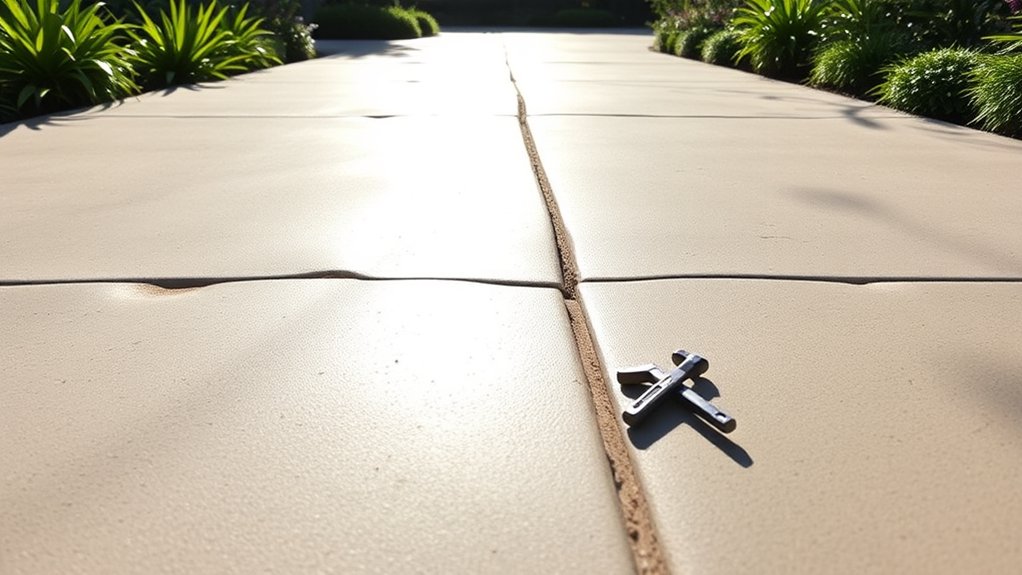
Maintaining your expansion joints is crucial for the durability of your concrete driveway. Setting up regular inspections helps you catch any damage early, saving you from expensive repairs later.
It’s also important to keep the joints clean by removing debris and plants, as this can prevent root damage and maintain joint integrity.
For sealing, use flexible, non-sag caulks or sealants specifically made for expansion joints, and remember to apply them with backer rods for extra support.
If repairs are needed, ensure you completely remove old filler for better adhesion and follow the manufacturer’s instructions regarding sealant thickness.
Keep an eye out for signs of joint failure, such as cracking or erosion. Address these issues quickly to prevent water from seeping in and causing further damage, which will help prolong the life of your driveway.
Importance of Proper Planning in Driveway Construction
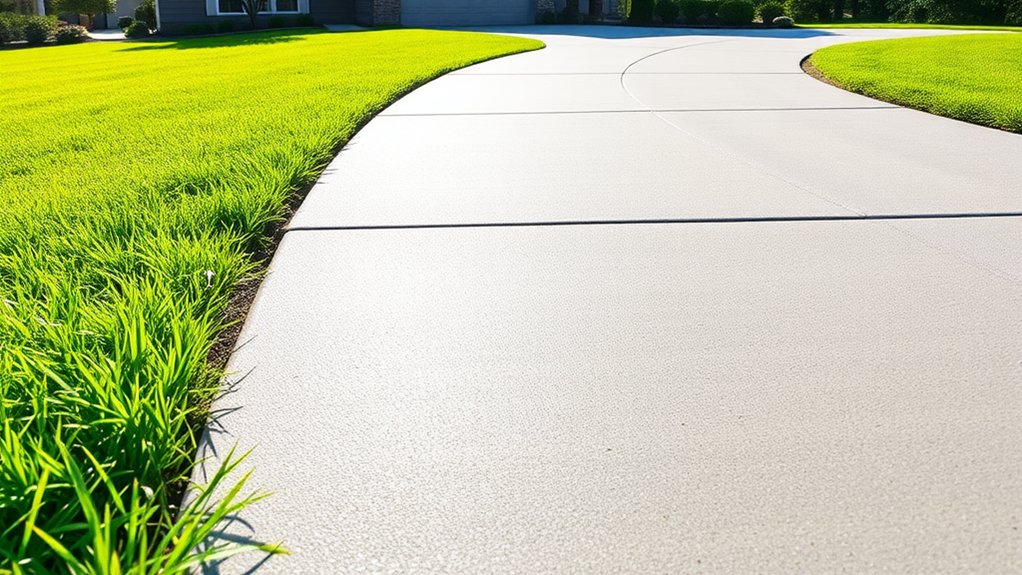
Proper planning is crucial for successful driveway construction, directly affecting both its longevity and functionality.
Start with a detailed site evaluation to decide on a design that suits your property layout and accommodates the number of vehicles you have. Choose an ideal location, taking into account existing landscape features and local regulations.
Assess the soil type to determine the required excavation depth and base preparation. Planning for an appropriate slope is essential to ensure effective water drainage and avoid surface pooling.
Use stakes and string to accurately outline the area. Each of these steps helps create a solid foundation, reducing the risk of future cracks and structural problems, which ultimately ensures your driveway lasts longer and performs better.
Long-term Benefits of Using Expansion Joints
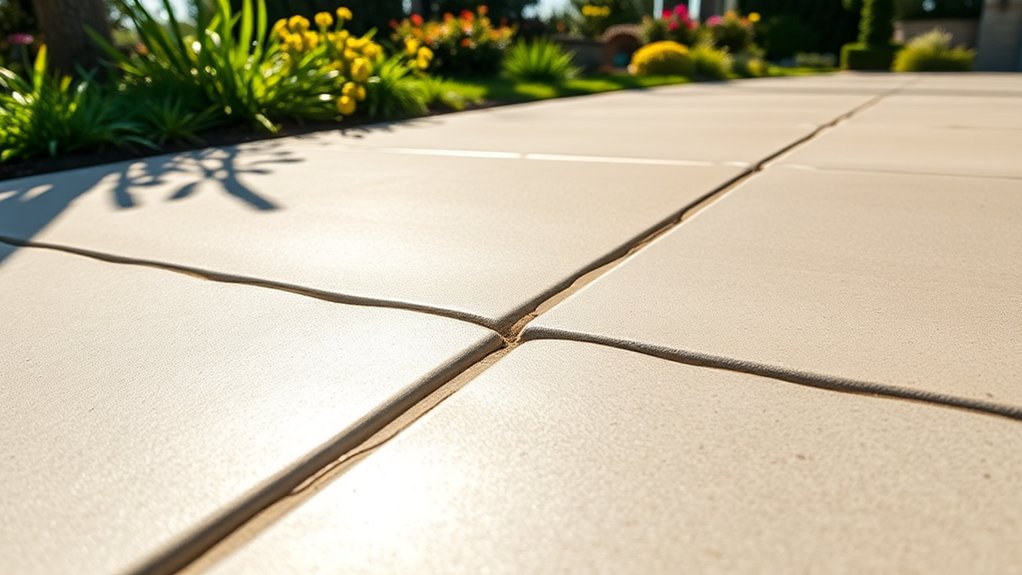
Incorporating expansion joints into your concrete driveway significantly improves its long-term performance and durability. These joints help prevent cracking and structural damage while allowing for controlled movement, ultimately extending the lifespan of your driveway. By minimising large-scale cracking, you can save considerably on repairs and maintenance.
| Benefit | Details | Impact |
|---|---|---|
| Structural Integrity | Absorbs stress from temperature changes | Reduces likelihood of cracking |
| Aesthetic Appeal | Keeps the surface smooth and level | Increases property value |
| Cost Efficiency | Eases maintenance and replacement efforts | Lowers overall expenses |
Frequently Asked Questions
How Often Should Expansion Joints Be Inspected?
Expansion joints should be inspected at least once a season, particularly in areas prone to extreme weather or heavy traffic. Regular inspections help catch any damage early, which is crucial for maintaining the longevity and structural integrity of your concrete installations. For instance, if you notice cracks or misalignment after a harsh winter, addressing these issues promptly can prevent more extensive repairs later on.
Can I Install Expansion Joints Myself?
Yes, you can install expansion joints yourself. Just ensure you follow essential tips, such as placing the joints correctly and using flexible materials. Keep in mind factors like timing and the right tools to achieve a successful and durable outcome, preventing any future issues. For example, if you’re working on a patio, make sure the joints are spaced appropriately to allow for movement, avoiding cracks.
What Happens if I Skip Expansion Joints Entirely?
If you skip expansion joints, you risk more cracking in your concrete, which undermines your driveway’s durability. This can lead to expensive repairs as stress builds up, shortening its lifespan and detracting from its appearance. You’ll also find that maintenance becomes more frequent due to faster deterioration.
Are There Different Types of Expansion Joint Materials?
You might think all expansion joint materials are identical, but that’s not the case. Rubber materials offer flexibility, making them ideal for areas with significant movement, while foam materials provide compressibility, suitable for lighter applications. Each type plays a unique role in accommodating concrete movement and preventing damage. Choose wisely!
How Do Weather Conditions Affect Expansion Joint Performance?
Weather significantly affects the performance of expansion joints. Fluctuations in temperature cause concrete to expand and contract, putting stress on the joints. If these joints aren’t designed or maintained properly, this constant movement can lead to issues such as cracking, spalling, and ultimately a shorter lifespan for the structure. For example, in colder months, concrete may contract, while in warmer months, it expands, highlighting the importance of ensuring that expansion joints are in good condition to manage these changes effectively.
Conclusion
Incorporating expansion joints in your concrete driveway is a simple yet important step that offers significant benefits. While it may seem tempting to skip them for cost reasons, the potential for cracks and structural problems can far exceed any initial savings. Properly planning and placing these joints is an investment in your driveway’s durability and lifespan. Don’t let a minor oversight undermine your investment; with the right approach, you can ensure a smooth and lasting surface for years to come.
Just how do stamped and plain concrete driveways compare in durability, cost, and aesthetics? Discover which option truly suits your Read more
Learn about the lifespan and durability of concrete driveways, and discover essential tips to ensure yours lasts for decades to Read more
How to enhance your gravel driveway's stability and durability? Discover key strategies that can transform your drive into a long-lasting Read more

